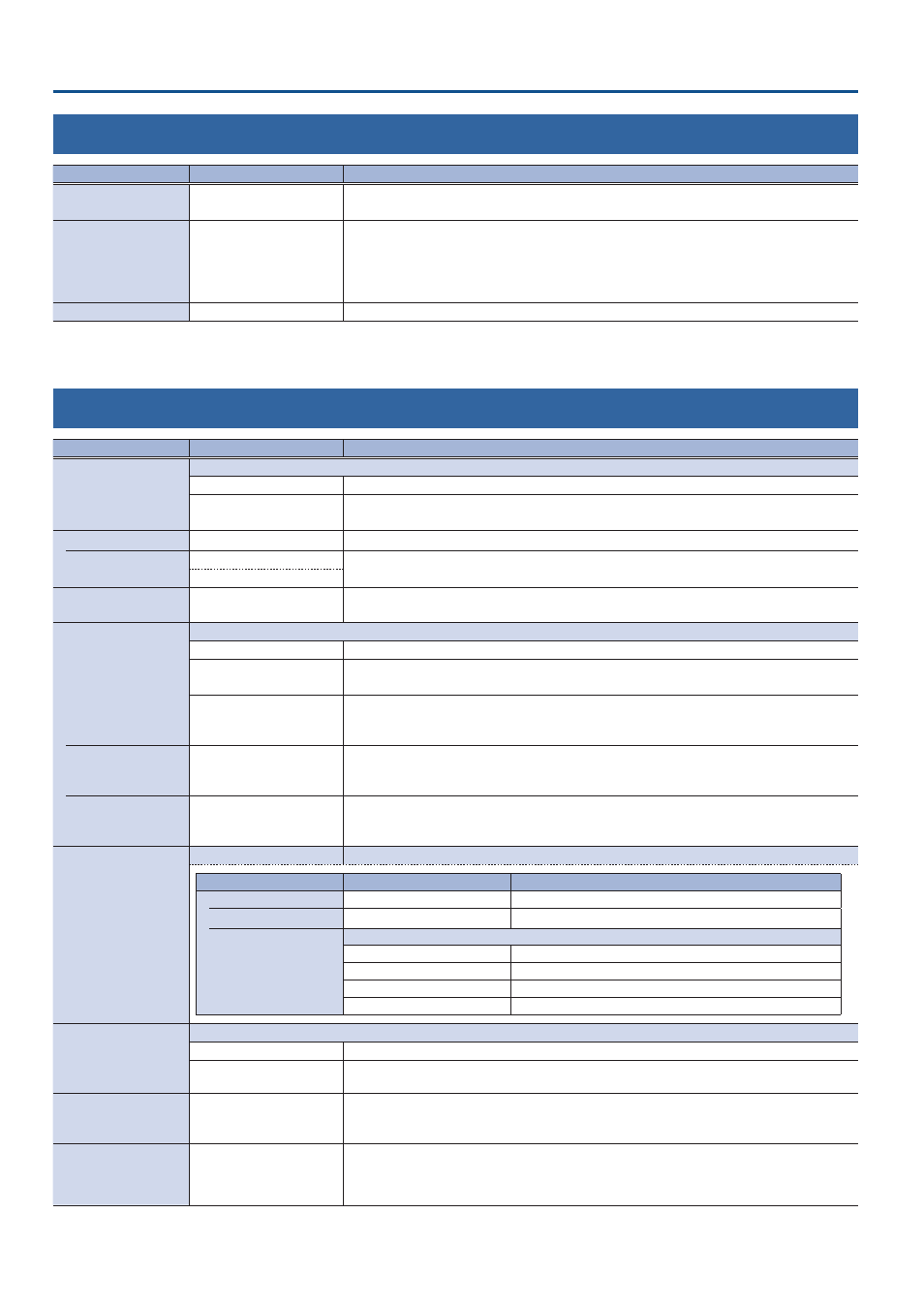Usb memory, System, Menu list – Roland V-160HD SDI/HDMI Streaming Video Switcher User Manual
Page 100

Menu List
100
23: USB MEMORY
Menu item
Value
(bold text: default value)
Explanation
RESTORE ALL SETTINGS
ENTER
Shows a list of the setting files (.V16) that are on the USB flash drive.
You can select a setting file and restore the settings into the unit. The current settings are overwritten.
BACKUP ALL SETTINGS
ENTER
Shows a list of the setting files (.V16) that are on the USB flash drive.
You can select the settings file used to back up the current settings to the USB flash drive. If you
selected “NEW FILE...,” a new settings file is saved.
* Some settings are not saved to the file, such as the “TEST PATTERN” and “TEST TONE” settings in
the SYSTEM menu.
FORMAT
EXEC
Formats the USB flash drive.
24: SYSTEM
Menu item
Value
(bold text: default value)
Explanation
HDCP
(*19)
Specifies whether HDCP is enabled (ON) or disabled (OFF).
OFF
Copy-protected (HDCP) video cannot be input.
ON
Copy-protected (HDCP) video can be input. HDCP is also added to the video that is output.
* Video/audio from the SDI OUT connectors and the USB STREAM port are not outputted.
FRAME RATE
(*19)
60, 59.94, 50Hz
Specifies the frame rate.
USB OUT
(*19)
29.97, 59.94Hz
Specifies the frame rate of the USB STREAM port.
* The value differs depending on the “FRAME RATE” setting.
25, 50Hz
SYSTEM FORMAT
(*19)
1080p
, 1080i, 720p
Specifies the system format.
* The output format of the HDMI OUT 3 connector is fixed at 1080p.
REFERENCE
Specifies the reference clock of the V-160HD.
INTERNAL
The V-160HD’s internal clock is used as the reference clock
EXTERNAL
A synchronizing signal input via the REFERENCE IN connector is used as the reference clock.
Black-burst (frame synchronization), bi-level, and tri-level synchronizing signals are supported.
SDI 1–8
A signal input via one of the SDI IN 1–8 connectors is used as the reference clock.
The VSYNC (vertical synchronizing) signal output from the V-160HD is synchronized to the VSYNC
signal input via SDI.
CLOCK ADJUST
-1920–
0
–1920
This adjusts the phase horizontally.
Adjust this when output is horizontally out of sync with the operation of other devices using the
same clock.
LINE ADJUST
-1200–
0
–1200
This adjusts the phase vertically.
Adjust this when output is vertically out of sync with or field-shifted from the operation of other
devices using the same clock.
Bluetooth
ENTER
Displays the Bluetooth PAIRING menu.
Menu item
Value
Explanation
Bluetooth
OFF
, ON
Turns the Bluetooth function on/off.
PAIRING
EXEC
Begins pairing with a Bluetooth device.
STATUS
Displays the Bluetooth connection status.
OFF
Bluetooth off
PAIRING MODE
Now pairing
NOT CONNECTED
Waiting for connection
CONNECTED
Connected
PANEL OPERATION
Specifies the operation mode for video transitions.
A/B
The video of the bus toward which the video fader is flipped always becomes the final output.
PGM/PST
The video on the PGM/A bus is always the final output. Select the preview output video (the video
to be output next) for the PST/B bus side.
EFFECTS TRANSITION
SYNC
OFF
, ON
Sets whether the PinP/DSK composites are switched on and off in tandem with the video transitions.
When this is “ON,” the PinP/DSK composition turn on/off in tandem with the video transitions. The
composited result that is previewed is sent to final output when transitioning to a different video.
EFFECTS SPOT
DISABLE,
ENABLE
Specifies whether the spot function for the [PVW] and [PGM] buttons is enabled (ENABLE) or
disabled (DISABLE).
With the spot function, long-pressing the [PVW] or [PGM] button for each layer shows only the
layer that is targeted for the operation while the button is pressed.
(*19) A change in the setting is not applied until you press the [VALUE] knob to confirm.
